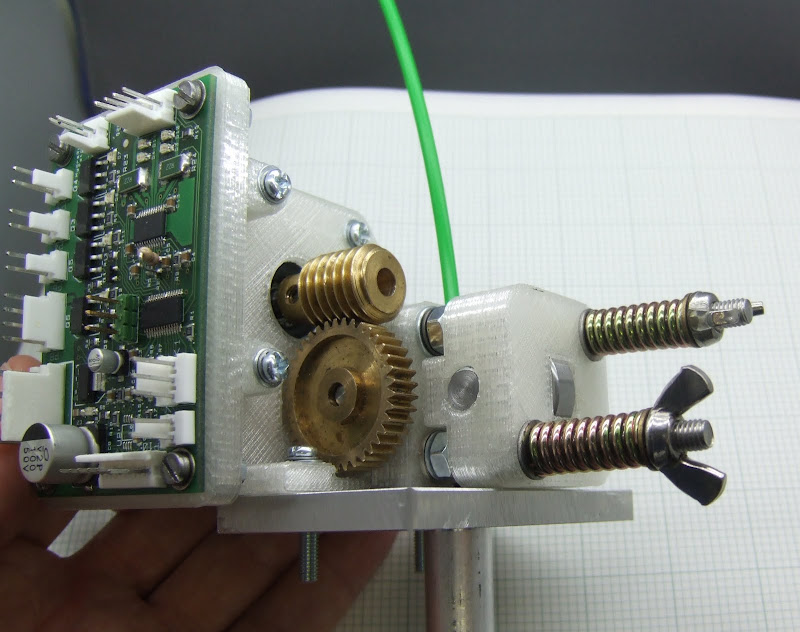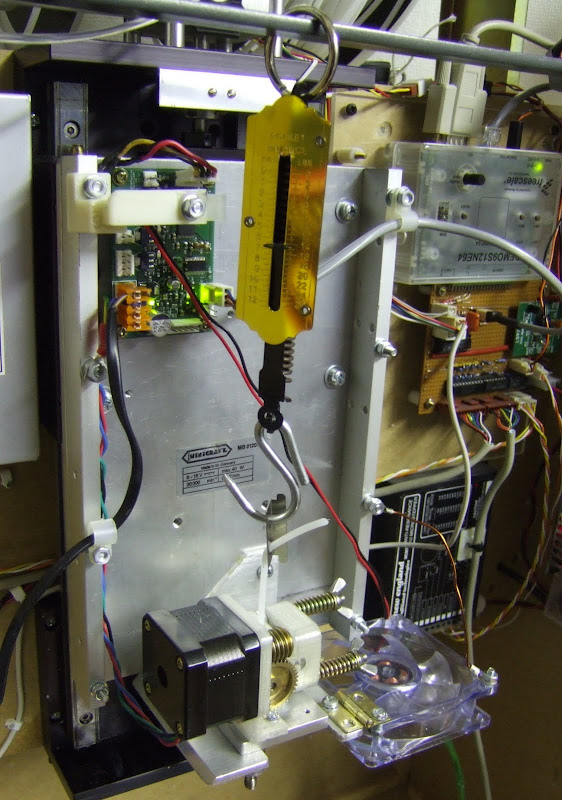One of the aims of my new design is to reduce the amount of molten plastic to minimise ooze. Also less molten plastic means less viscous drag. I also wanted to reduce the thermal mass (to reduce the warm up time) and completely cover the hot part with insulation to allow a fan to blow on the work-piece without cooling the nozzle.
To achieve these aims I switched to a smaller resistor (same resistance but less wattage) and mounted it horizontally rather than vertically. There is some risk that the resistor may fail but I think as long as it has good thermal contact with the aluminium block, so that its outside temperature is less than 240C, then I have a good chance it will last.
The smaller resistor also means a much smaller surface area so less heat is lost. T0 keep the molten filament path as short as possible I combined the heater and the nozzle and made it from one piece of aluminium. That also gives very good thermal coupling between the nozzle tip, the melt chamber, the heater and the thermistor.
 |  |
I turned it out of a block of aluminium using my manual lathe and a four jaw chuck, but I think I could also mill it out of 12mm bar using HydraRaptor.
A feature that I have used on my previous extruders is to cover as much of the nozzle as possible with PTFE. That stops the filament sticking so that it can be wiped off reliably with a brush. It also insulates the nozzle.
My previous nozzle cap implementations have been turned from PTFE rod. The downside of that is that the working face, that has been cut and faced on the lathe, is not as smooth and slippery as the original stock.

To cover the face of this version I used a 3mm sheet of PTFE so it has the original shiny surface.

Normally PTFE is too slippery to glue so my original plan was to screw it on with some tiny countersunk screws. However, the sheet I bought was etched on the back to allow it to be glued, so I stuck it on with RTV silicone adhesive sold for gluing hinges onto glass oven doors.

To insulate the rest of the heater I milled a cover out of a slice of 25mm PTFE rod.

I normally stick items to be milled onto the back of a floor laminate off-cut using stencil mount spray. I didn't think that was going to work with a PTFE cylindrical slice that is only a little bigger than the finished item. Instead I milled a hole in a piece of 6mm acrylic sheet that was already stuck down with stencil mount. The hole was slightly smaller than the PTFE so I faced it and chamfered it on the lathe and then hammered it in.

I roughed the shape with a 1/8" end mill and then sharpened the internal corners and cut the slots for the resistor leads with a 1mm end mill. I tried to mill the whole thing with a 1mm bit but it snapped due to a build up of burr in the deep pocket. On reflection it was silly to expect to be able to mill deep pockets with a 1mm bit and of course it is much faster to rough it with a bigger bit.

I used my normal technique of taking 0.1mm depth cuts at 16mm. That allows me to mill plastic with no coolant, but I expect I could have made much deeper cuts in PTFE. It mills very nicely, probably because it is soft and has a high melting point and low friction.
I haven't done any milling for a long time so for anybody new to my blog here is my the milling set-up: -

It is simply a Minicraft drill with some very sturdy mounts. The spindle controller I made originally would need its micro replaced as the one I used has a bug in its I2C interface. Instead I just connected it to the spare high current output on my new extruder controller.
The remaining part of the extruder is the stainless steel insulator.

I made the transition zone shorter than the last one I made because I wanted all of the inside of the transition to be tapered. The aluminium sleeve carries away the heat from the cold end of the transition to an aluminium plate that forms the base of the extruder. That in turn carries the heat to the z-axis via an aluminium bracket. I used heatsink compound on the joints.
Here is a view of the bottom half of the extruder: -

And here is a cross section showing the internal details: -

So that was the plan, what could go wrong? Well everything really! The first problem was that the resistor shorted out to the aluminium block. The smaller resistor only has a thin layer of enamel over its wire. Normally I wrap aluminium foil round it to make it a tight fit. I didn't drill the hole big enough so it was a tight fit with only one layer and pushing it in abraded the enamel. The solution would be a bigger hole and more layers of foil, but I just glued it with Cerastil as a quick fix. Of course it only failed after I had fully assembled it and run some heat cycles so I had to strip it down again to fix it. Not easy once the wiring has been added.
The next problem is that it leaks. I think it is because I dropped the extruder when I was building it and bent the thin edge at the end of the stainless steel barrel. That forms the seal with the heater block, so even though I straightened it I think the seal is compromised. I keep tightening it and thinking it is fixed but after hours of operation plastic starts to appear at the bottom of the PTFE cover.
The other problem is that mostly it extrudes very well, I now do the outline at 16mm/s and the infill at 32mm/s, but sometimes the force needed to push the filament gets higher and causes the motor to skip steps, or the bracket to bend so far that the worm gear skips a tooth.
I have made several objects taking between one and two hours and it worked fine. Other times, mainly when I was making small test objects with Erik, it will completely jam. Actually it seems to jam when it is leaking badly, which implies the pressure of the molten plastic is much higher as well as the force to push the filament. The only explanation I can think of is there is an intermittent blockage of the nozzle exit. More investigation required.
















































